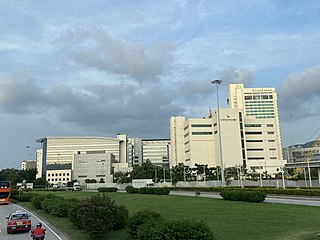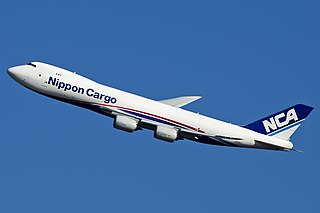
The Boeing 747 is a large, long-range wide-body airliner designed and manufactured by Boeing Commercial Airplanes in the United States between 1968 and 2023. After introducing the 707 in October 1958, Pan Am wanted a jet 2+1⁄2 times its size, to reduce its seat cost by 30%. In 1965, Joe Sutter left the 737 development program to design the 747. In April 1966, Pan Am ordered 25 Boeing 747-100 aircraft, and in late 1966, Pratt & Whitney agreed to develop the JT9D engine, a high-bypass turbofan. On September 30, 1968, the first 747 was rolled out of the custom-built Everett Plant, the world's largest building by volume. The 747's first flight took place on February 9, 1969, and the 747 was certified in December of that year. It entered service with Pan Am on January 22, 1970. The 747 was the first airplane called a "Jumbo Jet" as the first wide-body airliner.
Deutsche Lufthansa AG / Lufthansa German Airlines, commonly shortened to Lufthansa, serves as the flag carrier of Germany. When combined with its subsidiaries, it stands as the second-largest airline in Europe in terms of passengers carried, after the ultra low-cost carrier Ryanair, largest in Europe and fourth largest in the world by revenue. Lufthansa is also one of the five founding members of Star Alliance, which is the world's largest airline alliance, formed in 1997.
Continental Airlines was a major airline in the United States that operated from 1934 until its merger with United Airlines in 2012. It had ownership interests and brand partnerships with several carriers.

Cathay Pacific Airways Limited (CPA), more widely known as Cathay Pacific, is the largest carrier of Hong Kong with its head office and main hub located at Hong Kong International Airport. The airline's operations and its subsidiaries have scheduled passenger and cargo services to over 190 destinations and more than 60 countries worldwide including codeshares and joint ventures. Cathay Pacific operates a fleet consisting of Airbus A321neo, Airbus A330, Airbus A350, and Boeing 777 aircraft. Cathay Cargo operates two models of the Boeing 747. Defunct wholly-owned subsidiary airline Cathay Dragon, which ceased operations in 2020, operated to 44 destinations in the Asia-Pacific region from its Hong Kong base. In 2010, Cathay Pacific and Cathay Cargo, together with Cathay Dragon, transported nearly 27 million passengers and over 1.8 million tons of cargo and mail.

Singapore Airlines is the flag carrier of Singapore with its hub located at Changi Airport, and a member of the Star Alliance. The airline is notable for highlighting the Singapore Girl as its central figure in the corporate branding segment. Widely renowned as one of the best carriers, the airline is ranked as a 5-star airline by Skytrax, and it has also been ranked as the world's best airline five times. The airline operates a variety of Airbus and Boeing aircraft, namely the A350, A380, Boeing 737, Boeing 747 Freighter, Boeing 777 and Boeing 787.
Swiss International Air Lines AG, stylized as SWISS, is the flag carrier of Switzerland and a subsidiary of the Lufthansa Group, as well as a Star Alliance member. It operates scheduled services in Europe and to North America, South America, Africa and Asia. Zurich Airport serves as its main hub and Geneva Airport as its secondary hub.

The Airbus A340 is a long-range, wide-body passenger airliner that was developed and produced by Airbus. In the mid-1970s, Airbus conceived several derivatives of the A300, its first airliner, and developed the A340 quadjet in parallel with the A330 twinjet. In June 1987, Airbus launched both designs with their first orders and the A340-300 took its maiden flight on 25 October 1991. It was certified along with the A340-200 on 22 December 1992 and both versions entered service in March 1993 with launch customers Lufthansa and Air France. The larger A340-500/600 were launched on 8 December 1997; the A340-600 flew for the first time on 23 April 2001 and entered service on 1 August 2002.
Virgin Australia, the trading name of Virgin Australia Airlines Pty Ltd, is an airline based in Australia. It is one of two active airlines to use the Virgin brand, as well as the larger by fleet size. It commenced services on 31 August 2000 as Virgin Blue, with two aircraft on a single route. It suddenly found itself as a major airline in Australia's domestic market after the collapse of Ansett Australia in September 2001. The airline has since grown to directly serve 32 cities in Australia, from hubs in Brisbane, Melbourne and Sydney.
Luxair, legally Luxair S.A., Société Luxembourgeoise de Navigation Aérienne, is the flag carrier of Luxembourg with its headquarters and hub at Luxembourg Airport. It operates scheduled services to destinations in Europe, North Africa, the Mediterranean and Middle East with additional charter and seasonal services. It is Luxembourg's only passenger-carrying airline offering regular, non-charter service.
Bmibaby Limited was a British low-cost airline that flew to destinations in the United Kingdom and Europe from its bases at Birmingham and East Midlands airports. It was a subsidiary of British Midland International, itself wholly owned by International Airlines Group (IAG). Bmibaby's head office was at Donington Hall in Castle Donington, North West Leicestershire, England. Bmibaby held a United Kingdom Civil Aviation Authority Type A Operating Licence, and was permitted to carry passengers, cargo and mail on aircraft with 20 or more seats.
Germanwings GmbH was a German low-cost airline wholly owned by Lufthansa which operated under the Eurowings brand. It was based in Cologne with hubs at Cologne Bonn Airport, Stuttgart Airport, Hamburg Airport, Berlin Tegel Airport, Munich Airport and further bases at Hannover Airport and Dortmund Airport.

The Boeing 747-8 is the final series of the large, long-range wide-body airliners in the Boeing 747 family from Boeing Commercial Airplanes. The 747-8 is the largest variant of the 747 and Boeing's largest aircraft. After introducing the 747-400, Boeing considered larger 747 versions as alternatives to the proposed double-deck Airbus A3XX, later developed as the Airbus A380. The stretched 747 Advanced was launched as the 747-8 on November 14, 2005, for a market forecast of 300 aircraft. The first 747-8F Freighter performed its maiden flight on February 8, 2010, and the passenger 747-8I Intercontinental followed suit on March 20, 2011. The cargo version was first delivered in October 2011 and the airliner began commercial service in June 2012.
Austrian Airlines AG, often shortened to Austrian or AUA, is the flag carrier of Austria and a subsidiary of the Lufthansa Group. The airline is headquartered on the grounds of Vienna International Airport in Schwechat where it also maintains its hub. As of July 2016, the airline flew to six domestic and more than 120 international year-round and seasonal destinations in 55 countries and is a member of the Star Alliance.

In-flight entertainment (IFE) refers to the entertainment available to aircraft passengers during a flight. In 1936, the airship Hindenburg offered passengers a piano, lounge, dining room, smoking room, and bar during the 2+1⁄2-day flight between Europe and America. After World War II, food and drink services were offered, and movies were projected onto big screens viewable by all passengers on long flights. In 1985 the first personal audio player became available for purchase, and noise cancelling headphones were introduced in 1989. During the 1990s, the demand for better IFE was a major factor in the design of aircraft cabins. Before then, entertainment came via audio headphone sockets and airline-provided headphones providing music of various genres and the soundtrack of projected movies. Now, in most aircraft, personal IFE display screens are available at most seats, offering entertainment and flight information such as a moving map, speed, and altitude. The advent of small entertainment and communication devices also allows passengers to also use their own devices, subject to regulations to prevent them interfering with aircraft equipment.
SITAONAIR is a company that enables airline passengers to use their smart devices including mobile phones and laptops for calls, text messaging, emails and Internet browsing.

Gogo Business Aviation is a division of Gogo Inflight Internet is a provider of in-flight broadband Internet service and other connectivity services for business aircraft. It is headquartered in Broomfield, CO.

Lufthansa Technik AG provides worldwide maintenance, repair, and overhaul (MRO) services for aircraft, engines, and components. It is a subsidiary of the Lufthansa Group.

Gogo Inc. is an American provider of in-flight broadband Internet service and other connectivity services for business aircraft, headquartered in Broomfield, Colorado. Through its Gogo LLC subsidiary, Gogo previously provided in-flight WiFi to 17 airlines until the Commercial Air business was sold to Intelsat for $400 million in December 2020. According to Gogo, over 2,500 commercial aircraft and 6,600 business aircraft have been equipped with its onboard Wi-Fi services. The company is the developer of 2Ku, new in-flight satellite-based Wi-Fi technology rolled out in 2015.
AeroMobile Communications Limited is a registered mobile network operator for the aviation industry and is based in the UK. It provides technology and services that allow the safe use of passengers' own mobile phones while inflight. A subsidiary of Panasonic Avionics Corporation its services are often installed alongside Panasonic's Wi-Fi network and can be installed either at the point of aircraft manufacture or retro-fitted across both Airbus and Boeing aircraft. Panasonic Avionic's Wi-Fi network and AeroMobile's mobile phone network are complimentary services and provide passengers with a choice of inflight connectivity options.
FlyNet is an onboard communication service for Lufthansa.











